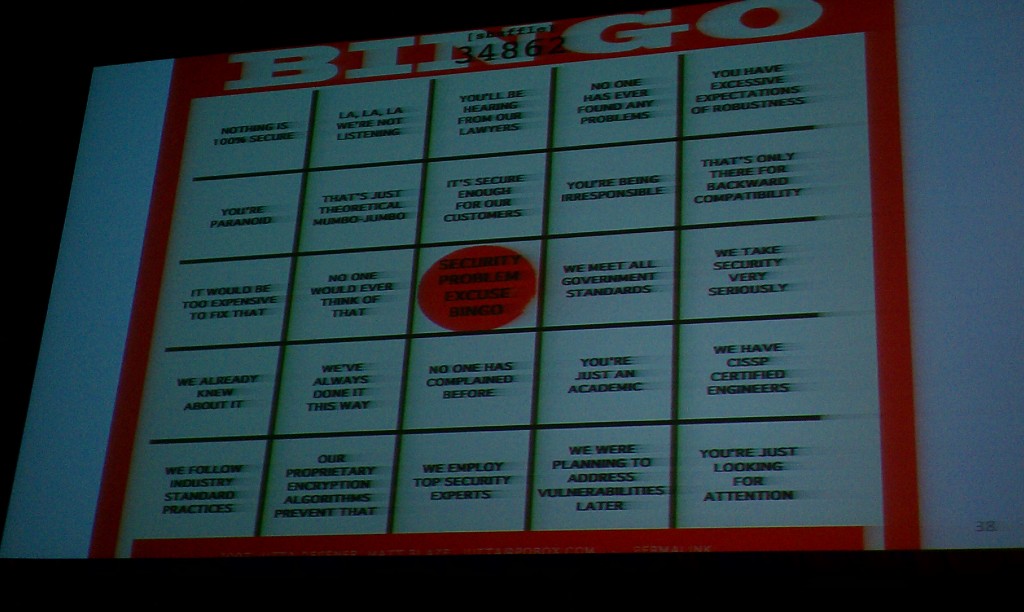Note: I’ve updated the day 1 notes with a couple of things I forgot to include last night.
“Defeating PPTP VPNs and WPA2 Enterprise with MS-CHAPv2“:MS-CHAPv2 is a wildly popular authentication protocol. For example, DEFCON’s “secure” network uses MS-CHAPv2. People have been attacking CHAP for a while now, but most of the attacks are dictionary attacks, where you use asleap and throw a word list at it, hoping the user picked a weak password.
So is MS-CHAPv2 security password dependent? That’s a reasonable assumption, but not true.
If you look at the details of the MS-CHAPv2 handshake (Moxie had a good visualization, which I can’t find online or I’d link to it here) there’s only one unknown: the MD4 hash of the user’s password. Everything else is sent in the clear, or can be derived from known information.
MS-CHAP does a series of three DES encryptions on the user password. But it isn’t 3DES: it is just three DES encryptions with three keys. One of those keys is padded so it is really only two bytes, which makes it easy to crack. The other two encryptions use the same plaintext; the end result is that the complexity of cracking MS-CHAP DES reduces to about the same as normal 56-bit DES, 2 to 56th power.
Enter the folks at Pico Computing, about whom I have written before. Pico built a machine with 48 FPGA chips, each with 40 cores running at 450 MHz, to attack DES. This machine can search the whole keyspace in about 23 hours. And Pico has come up with some clever optimizations for the FPGAs: preconfiguring memory, reducing the bus down to “key found/key not found” (since searching the keyspace is linear, if you know when the bus went to “key found”, you can figure out what the key is), and possibly just using JTAG instead of a bus.
“So what,” you say. “I don’t have a single FPGA, let alone 48 of them.”
Enter chapcrack. Do a packet capture, point chapcrack at it, and chapcrack will pull out the MS-CHAP handshake, in a handy form which you can submit to…
…CloudCracker.com, which now supports MS-CHAPv2 attacks. Estimated turn-around time is one day. Woo hoo woo hoo hoo.
(Edited to add: Added a link to a blog post by Moxie Marlinspike summarizing his and David Hulton’s (of Pico Computing) presentation 8/1/2012.)
“Exploit Archaeology: Raiders of the Lost Payphones”:More of a fun panel than a practical one, covering all the stuff the presenter went through to find documentation and tools for an old Elcotel payphone he was given. Among other things:
- The upper housing lock (which covers the internal phone mechanism, including the reset to defaults button) is a relatively easy to pick 3-pin lock (with “anti-impressioning divots”).
- The lower housing (where the money is stored) is a much harder to pick 4-pin lock. But the presenter got lucky…
- You also need a special tool, called a T-wrench, to do certain things. The presenter was able to improvise one…
So once you’ve got a payphone, what can you do with it? You can hook it to an ATA and connect to an Asterisk system, and have some fun that way. (The presenter pointed out that by law, 911 calls are required to be free. So he had some fun connecting the payphone to his Asterisk system, and configuring it so dialing 911 on the payphone got an outside line through Asterisk.)
Anyway, it turns out that there are three ways to program/reprogram these phones: there was specialized software available (Elcotel has been out of business for years, but the presenter managed to get a copy of the software, crack it, and get it running), local telemetry (where you open up the upper housing, reset the phone, and let it guide you through voice prompts for reprogramming), or remote telemetry (the phone has a modem). VOIP, by the way, is not well suited to modems.
Some notes:
- these phones have a default ID of 9999
- a default password of 99999999
- a secondary password of 88888888
- The phone ID is generally set to the last four digits of the phone number.
- And the passwords are frequently left at the default.
There’s some other fun stuff you can do with an old payphone. For example, the presenter managed to rig up his phone, a Pwn Plug, and some custom scripting into a system that allows you to run NNmap port scans over the phone. But I’ll leave details of that for his presentation when he puts it up.
“Into the Droid: Gaining Access to Android User Data“: Excellent presentation covering some of the ways you can get user data out of an Android device, even if it is locked or encrypted. For example:
- you can use the abootimg tool to create a custom boot image, intercept the phone’s bootloader, and force it to use your image.
- Special USB debug cables work on some devices.
- The salt for the lockscreen and system passwords can be pulled out of specific locations on the device and cracked with something like oclhashcat-lite. (See the presentation for specific details on where the salt and key are located.)
- Applications with no permissions can still create a root shell and send information back to an end user (by hiding data in URL parameters, for example).
- There’s a specific distribution, Santoku Linux, designed for mobile device forensics (both IOS and Android). This is a work in progress, per the presenter…
(While I’m at it, let me say that I’m really impressed with viaForensics, especially their presentation page. Not only did they have the DEFCON presentation up, but it looks like there’s a lot of other good stuff there as well. I’m particularly interested in “iPhone Forensics with free and/or open source tools” and the “Android Forensics Training Presentation“.)
“Off Grid Communications with Android – Meshing the Mobile World”: Solid presentation discussing the Android networking stack, hacking the stack and flipping chipsets into ad-hoc mode, and network routing algorithms. End result: the SPAN project on github, which provides open-source tools for Android mesh networks. (There’s also a paper in that repository that covers the same ground as the presentation, including sexy diagrams of the Android network stack.)
“The Safety Dance – Wardriving the Public Safety Band”:Basically: public safety providers are moving into the 4.9 GHz band. And it is possible to monitor their traffic using equipment bought for cheap off eBay, or equipment that, with the right drivers, can be tuned down to 4.9 GHz. One of the presenters has a blog entry here that covers some of what was in the presentation, and the github repository of their patched drivers, etc. can be found here.
I missed Kaminsky’s “Black Ops” presentation for reasons of the Penn and Teller theater being full, and I can’t find it online (yet). So I wandered over to Renderman’s “Hacker + Airplanes = No Good Can Come Of This” and got there a little late; late enough, as it turned out, that I missed Renderman observing that he was constantly being scheduled on panels opposite Kaminsky, and darn it, he’d really like to see a Kaminsky panel.
But I digress.
So have you ever wondered how things like PlaneFinder work? As part of the government’s efforts to bring air traffic control into the 20th Century, they’ve implemented something called ADS-B. Planes equipped with ADS-B transmitters send out data (such as their aircraft ID, altitude, GPS coordinates, bearing, and speed), which is picked up by ground stations and fed into the systems that feed PlaneFinder and other such sites. There’s two types: ADS-B Out, which is sent automatically as a broadcast, and ADS-B In, which allows planes to listen to each others ADS-B Out broadcasts, so that (in theory) they’re aware of each other without needing air traffic control.
(According to the presentation that followed Renderman, ADS-B is at about 70% penetration for commercial aircraft, and much lower for general aviation. The government’s goal is to have the majority of traffic on the system by 2020.)
When does this get interesting? Right about now. First of all, anyone can build a ground station and receive ADS-B broadcasts. Renderman has. (I understand there’s been quite a bit of work on using cheap-ass USB digital TV tuners as ADS-B receivers.) That gets you access to the flight data going over your head.
But wait, there’s more! ADS-B has no authentication and no encryption built in. That means anyone with the proper equipment (a radio that transmits at 1090 MHz) can spoof ADS-B broadcasts.
Remember the part above about how planes could use ADS-B to keep track of each others positions, bypassing ATC? Have you booked your Amtrak ticket yet?
As ADS-B usage grows, attacks are likely to become more disruptive. What happens if someone starts jamming ADS-B signals? Or inserting fake flight data? Or has the same fake plane in two places at once? The official response, according to Renderman, boils down to “trust us”. “Us” being the same folks who brought you Operation Fast and Furious. Pull the other one, guys; it has bells on.
Edited to add: Link to Renderman’s slides for this presentation added 8/1/2012.
“Busting the BARR: Tracking ‘Untrackable’ Private Aircraft for Fun & Profit”: A semi-related panel to Renderman’s. So how does PlaneFinder get the data that comes from ADS-B broadcasts? The FAA has a feed (called ASDI: Aircraft Situation Display to Industry); they’ll send you the data in XML format, and you can parse it and display it and hug it and squeeze it and call it George, if you want.
However, the FAA also has something called the “Block Aircraft Registration Request”. If you’re someone who doesn’t want their flight information made public, you can put your aircraft on the BARR list. This doesn’t strip your data out of the ASDI feed; that’s still there, but sites that use ASDI (like FlightAware) can’t display information for flights on the BARR. (If you want to subscribe to the ASDI feed, write an XML parser, and be notified every time Jay Z’s plane takes off and lands, more power to you. You just can’t share that information with others.)
So how did the presenters work around that? Their project basically comes down to:
- Monitoring LiveATC.net and downloading ATC communications.
- Using speech recognition to pull out flight information (such as tail numbers of planes).
- Profit. Or in this case, OpenBARR.net, which is still in testing.
That was enough excitement for one day. I seriously thought about entering the DEFCON Beard Competition, but I couldn’t tell if there was a cash prize and I don’t want the IOC revoking my status as an amateur.

